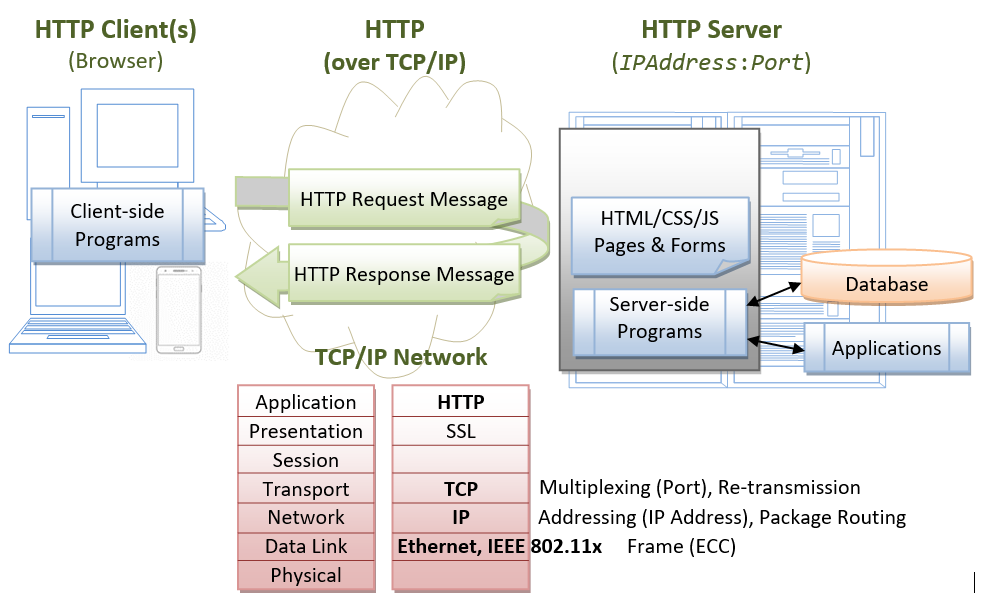1. Introduction of Web Server (Apache Web Server)
Starting, stopping, and restarting are the most widely used operations used for Apache Web Server. We can use start, stop, and restart commands to start, stop and restart the Apache web server in Linux, respectively. The commands to start, stop and restart Apache vary based on the Linux distribution we are using. Jul 23, 2016 Introduction to Apache Web Server. Difference between Apache http and Apache Tomcat. How to Install and Run Apache Web Server on Ubuntu Linux. How to Install and Run Apache Web Server on Windows 10. Original Article: So, crack those knuckles and follow along. Apache is a software, so we have to download it, visit the site.
A web server generally hosts the web content, and responds to requests for this content from web browsers such as Internet explorer, Google chrome and Firefox. The example of web server are apache web server, IIS web server, Nginx webserver and litespeed web server.
Technically, a web server is a daemon that speaks the https(s) protocol, a text-based protocol for sending and receiving object over a network connection. The http protocol is sent over the wire in clear text, using port 80/TCP by default (though other ports can be used).
There is also a TLS/SSL encrypted version of the protocol called https that uses port 443/TCP by default.
This article will discuss more on the most popular web server, Apache httpd server.
2. What is apache web server (Apache HTTPD) ?
Apache web server or Apache http server is one of the most widely used on the Internet. It is developed and maintained by Apache Software Foundation, Apache is an open source software available for free.
Beside Apache, IIS and Nginx also among the most common web servers in use today.
Based on survey by [news.netcraft.com] in June 2016, Apache Web server regained the lead from Microsoft IIS with a large increase.
Meanwhile, the portal [trends.builtwith.com/web-server] reported (July 18, 2016) the web server statistics shows that from the entire internet web, there are 46% web server running in Apache, 29% in Microsoft IIS and 19% in Nginx.


3. Apache Web Server packages in RHEL and CentOS Linux
In Red Hat Enterprise Linux 7 and CentOS 7, there is a group of package called “Web Server”. It includes the following software :
A default dependency of the httpd package is the httpd-tools package. This package includes tools to manipulate password maps and databases, tools to resolve IP address in log files to hostnames, and apache benchmark tool (ab). ab tool is very useful to perform a stress-test to the apache web server.
If you use Apache for your development server or Linux administrator who manages the corporate website in the apache web server, know how to setup and configure Apache will be important.
4. Install Apache Web Server Linux
This article explains the steps to install and configure Apache web server in RHEL 7 / CentOS 7 linux.
Please login to your CentOS 7 server to run below command :
a. How to install Apache web server only :
b. Apache web server installation from apache group packages :
c. How to start, stop and restart Apache Linux web server :
The following steps shows how to start, stop and restart the apache is for RHEL 7 and CentOS 7 operating system. The command will differ slightly in other linux distributions.
d. To start Apache service:
e. To stop Apache service:
f. To restart Apache service :
g. How to enable Apache web server at boot :
5. Configure Apache http Server In Linux
5.1. Overview of apache httpd conf file :
The httpd.conf is the primary configuration file in Apache Web Server in RHEL and CentOS. It is located at /etc/httpd/conf folder. It is a text file and consist of directives, containers and comments.
Example of directives in httpd.conf :
Example of containers :
Containers enclose one or more directives.
Example of comments :
5.2 Configure Apache httpd.conf configuration file
There are a few apache configuration need to alter before you can start running the apache web server. All the main configuration file is in httpd.conf file :
Modify below directives and matches the value to your web server environment :
ServerAdmin email address
This is where your problem with the server should be e-mailed. This address appears on some server-generated pages, such as error documents.
For example:
DocumentRoot directory-path
The top level directory for Apache server content. The apache user requires read access to any files and read and execute access to the directory and any of its sub-directories. Do not place a slash at the end of the directory path.
For example:
ServerName FQDN[:port]
Specifies the fully qualified domain name or IP address of the httpd server and an optional port on which the server listens. The FQDN must be resolvable to an IP address.
If you do not specify a FQDN, the server performs a reverse-name lookup on the IP address. If you do not specify a port, the server uses the port corresponding to the incoming request.
For example:
AllowOverride Directive
In Apache 2.4, AllowOverride is set to None by default. When AllowOverride is set to None , then .htaccess files are completely ignored. In this case, the server will not even attempt to read .htaccess files in the filesystem.
When AllowOverride directive is set to All, then any directive which has the .htaccess Context is allowed in .htaccess files.
htaccess is short for Hypertext Access, is a configuration file for use on web servers running the Apache Web Server software. Most of the developers today use htaccess to configure the details of the blog or website without needed to alter the server config files.
For Example :
How To Start Apache Web Server
If you run a single web site, above configuration is sufficient for your apache web server.
To apply the new configuration, restart or reload the Apache web service :
or
Access the web server ip address :
If you run multiple websites, you can configure Apache virtual Host as mentioned on 5.3 below :
5.3 Configure Apache Virtual Hosts
Apache virtual hosts allow a single httpd web server to serve content for multiple domains or websites. Virtual host is defined in a Virtual Host container. The multiple virtual containers for multiple domains is specify in the VirtualHost directive.
Where to specify VirtualHost directive ?
Virtual hosts are configured using the <virtualhost> block inside the main configuration.
For ease of administration, i would recommend this virtual host blocks are not defined inside /etc/httpd/conf/httpd.conf. Instead, please create new separate configuration files in /etc/httpd/conf.d/.
Create separate configuration file to specify <virtualhost> block:
For Example :
The document root specifies in each containers or virtualhost blocks is applicable to this virtual host and overrides any DocumentRoot directive elsewhere in the configuration.
Upload sample index.html or index.php into both document root (/var/www/html/website1 and /var/www/html/website2).
Start Apache Web Server Linux
To apply the new configuration, restart or reload the Apache web service :
or
6. Configure Firewalld to allow access to Apache http Server In Linux
By default, port 80 is blocked. Allow HTTP service in firewalld (host-based firewall for centOS 7). HTTP uses 80/TCP and HTTPS uses 443/TCP.
Finally, you can access both virtual URL will return you different contain :
Related Posts
Restart Apache Web Server Windows
- How to Install Apache Httpd Web Server on Linux
Apache Httpd is a common web server that was used in World Wide Web. It…
- How to Install Apache Httpd Server on RHEL 6
In this post, i will show on how to install Apache Httpd server on Redhat…
- How to Install Nginx Web Server on CentOS 6.3
Nginx or “engine x” is a free, open-source HTTP server and one of the alternative…
- How to Install FTP Server Linux using ProFTPd
Proftpd is one of the most popular FTP server, secure and reliable for the Linux…
- How to List Available Apache httpd Web Server Package and Info on CentOS 6.2
In this post, i will show on how to list available Apache httpd web server…
